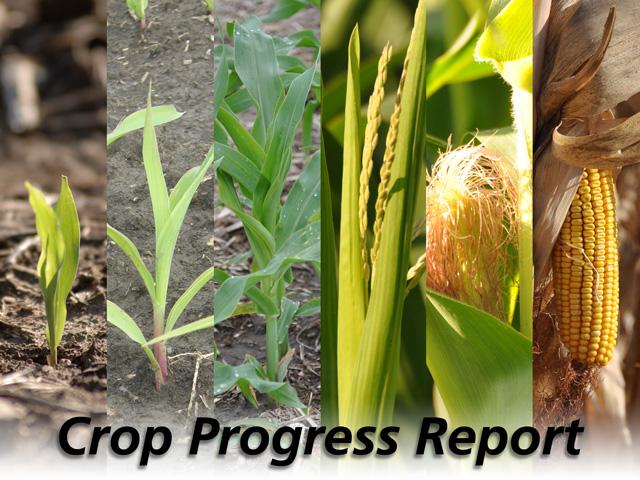USDA Weekly Crop Progress Report
USDA Crop Progress Report: Corn, Soybean Conditions Down Slightly Week Ended Aug. 14
This article was originally posted at 3:03 p.m. CDT on Monday, Aug. 15. It was last updated at 3:42 p.m. CDT on Monday, Aug. 15.
**
OMAHA (DTN) -- More hot, dry weather in parts of the country last week continued to put pressure on corn and soybeans, resulting in 1-percentage-point drops in the national good-to-excellent ratings for both crops, USDA NASS reported in its weekly Crop Progress on Monday.
CORN
-- Crop development: 94% of corn was silking as of Sunday, Aug. 14, according to NASS, 3 percentage points behind the five-year average of 97%. Corn in the dough stage was estimated at 62%, also 3 percentage points behind the five-year average of 65%. Corn dented was estimated at 16%, 4 percentage points behind the average of 20%.
-- Crop condition: 57% of corn was rated in good-to-excellent condition, down 1 percentage point from 58% the previous week and 4 percentage points below last year's rating of 62%. "Illinois and Iowa corn conditions are rated at 73% and 66% good to excellent, respectively, while Kansas, Kentucky and Missouri are poorly rated, at 29%, 32% and 46% good to excellent, respectively," said DTN Senior Analyst Dana Mantini.
SOYBEANS
-- Crop development: 93% of soybeans were blooming, equal to the five-year average. Seventy-four percent of soybeans were setting pods, 3 percentage points behind the five-year average of 77%.
P[L1] D[0x0] M[300x250] OOP[F] ADUNIT[] T[]
-- Crop condition: 58% of soybeans were rated in good-to-excellent condition, down 1 percentage point from 59% the previous week but 1 percentage point above last year's rating of 57%. "It is the eighth-lowest rating since 2000," Mantini said. "Illinois and Iowa were rated at 69% and 63% good to excellent, respectively. Wisconsin had the best rating, at 77% good to excellent, while, as in corn, Kansas, Kentucky and Missouri were poorly rated. That portion of the crop rated very poor to poor nationally jumped 1 point to 12% versus the previous week."
WINTER WHEAT
-- Harvest progress: 90% of the crop was harvested as of Sunday, 4 percentage points behind the five-year average of 94%. "Northwestern states are lagging in their winter wheat harvest, with Idaho at 28%, Washington at 45% and Montana at 71%, all behind the five-year average," Mantini said.
SPRING WHEAT
-- Harvest progress: 16% of the crop was harvested as of Sunday, 39 percentage points behind 55% last year and 19 percentage points behind the five-year average of 35%.
-- Crop condition: 64% of the crop was rated in good-to-excellent condition, unchanged from the previous week but far above last year's rating of 11%. "Minnesota's spring wheat condition posted a 6-percentage-point gain to 80% good to excellent, and North Dakota fell 1 point to 72% good to excellent," Mantini said. "Montana continues to be poorly rated, at just 38% good to excellent."
THE WEEK AHEAD IN WEATHER
Much of the country's midsection will get some relief from the extreme heat this coming week, according to DTN Ag Meteorologist John Baranick.
"A cold front will push south through the country this week," Baranick said. "Temperatures will be maintained east of the Mississippi River, but across the Plains, temperatures are falling to more seasonable values.
"On the leading edge of the cold front, moderate to perhaps heavy rain is falling in the mid-Missouri Valley Monday afternoon. This batch of rain will track into the Southeast over the next couple of days, running through southern Iowa, Missouri, and the northern Delta states, all areas that are in desperate need of rainfall. Parts of Kansas, Oklahoma and Texas that are deep in drought will see some isolated showers out of the front but will have to be thankful for the reduction in temperatures instead of any widespread heavy rain for their crops.
"The cooler temperatures will be sticking around for an extended period, likely through next week as well. It will remain hot across the West and into Montana and the Canadian Prairies, however, where stress is likely to be higher and could be damaging to the final stages of filling spring wheat."
To view weekly crop progress reports issued by National Ag Statistics Service offices in individual states, visit http://www.nass.usda.gov/…. Look for the U.S. map in the "Find Data and Reports by" section and choose the state you wish to view in the drop-down menu. Then look for that state's "Crop Progress & Condition" report.
**
Editor's Note: How are your crops looking? Are they better, worse or right on track with USDA NASS' observations this week? Send us your comments, and we'll include them in next week's Crop Progress report story. You can email comments to Anthony.greder@dtn.com or direct message him on Twitter @AGrederDTN. Please include your first and last name and the location where you farm.
| National Crop Progress Summary | ||||
| This | Last | Last | 5-Year | |
| Week | Week | Year | Avg. | |
| Corn Silking | 94 | 90 | 98 | 97 |
| Corn Dough | 62 | 45 | 71 | 65 |
| Corn Dented | 16 | 6 | 20 | 20 |
| Soybeans Blooming | 93 | 89 | 94 | 93 |
| Soybeans Setting Pods | 74 | 61 | 80 | 77 |
| Cotton Setting Bolls | 80 | 69 | 73 | 78 |
| Cotton Bolls Opening | 15 | 9 | 9 | 14 |
| Winter Wheat Harvested | 90 | 86 | 97 | 94 |
| Spring Wheat Harvested | 16 | 9 | 55 | 35 |
| Sorghum Headed | 67 | 55 | 80 | 77 |
| Sorghum Coloring | 30 | 25 | 30 | 32 |
| Oats Harvested | 58 | 46 | 73 | 67 |
| Barley Harvested | 31 | 13 | 51 | 41 |
| Rice Headed | 84 | 69 | 84 | 86 |
| Rice Harvested | 11 | 5 | 11 | 11 |
**
| National Crop Condition Summary | |||||||||||||||||
| (VP=Very Poor; P=Poor; F=Fair; G=Good; E=Excellent) | |||||||||||||||||
| This Week | Last Week | Last Year | |||||||||||||||
| VP | P | F | G | E | VP | P | F | G | E | VP | P | F | G | E | |||
| Corn | 6 | 10 | 27 | 45 | 12 | 6 | 10 | 26 | 46 | 12 | 4 | 9 | 25 | 47 | 15 | ||
| Soybeans | 3 | 9 | 30 | 48 | 10 | 3 | 8 | 30 | 49 | 10 | 4 | 11 | 28 | 45 | 12 | ||
| Spring Wheat | - | 6 | 30 | 58 | 6 | 1 | 7 | 28 | 55 | 9 | 28 | 35 | 26 | 10 | 1 | ||
| Sorghum | 15 | 23 | 35 | 25 | 2 | 14 | 21 | 36 | 27 | 2 | 3 | 7 | 30 | 52 | 8 | ||
| Cotton | 16 | 19 | 31 | 29 | 5 | 17 | 17 | 35 | 28 | 3 | 1 | 4 | 28 | 50 | 17 | ||
| Rice | - | 3 | 22 | 60 | 15 | - | 3 | 23 | 57 | 17 | 1 | 3 | 22 | 58 | 16 | ||
| Barley | - | 9 | 33 | 51 | 7 | 3 | 11 | 31 | 48 | 7 | 25 | 26 | 26 | 19 | 4 | ||
Anthony Greder can be reached at anthony.greder@dtn.com
Follow him on Twitter @AGrederDTN
(c) Copyright 2022 DTN, LLC. All rights reserved.




